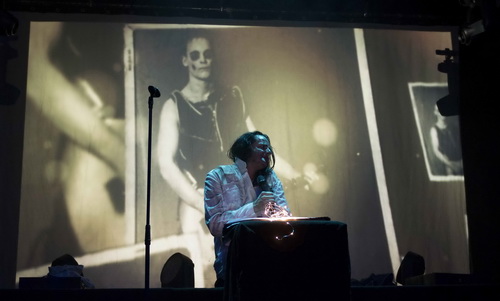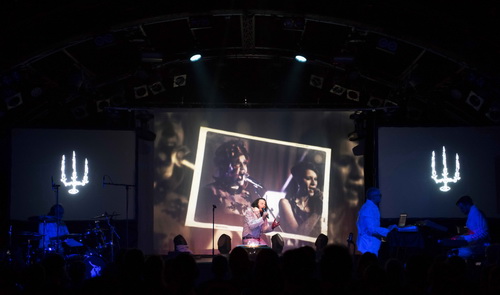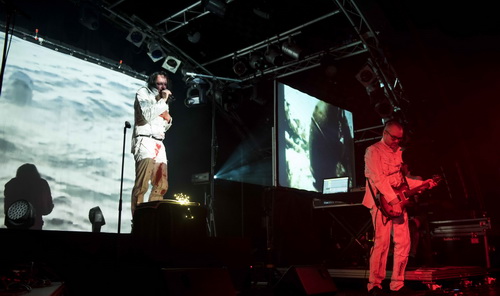
Graceful and majestic darkwave – Goethes Erben interviewed
Posted In Interviews,Slider by Jimi Nilsson
At the end of the eighties, darkwave in Germany crystallized into the Neue Deutsche Todeskunst, where music influenced by goth rock and neo-classical pieces were combined with German-spoken lyrics paying homage to philosophers as Goethe and Nietzsche.
One of the pioneering bands released the classic NDT album, also their debut album, “Das Sterben ist ästhetisch bunt” in 1992 and celebrates 30 years on the scene. After a thirteen-year long hiatus, Gothes Erben returned with the album “Am Abgrund” and have embarked on a very expensive theatrical tour, continuing in 2019 in chamber concert halls across Germany making their 30th year something to remember.
When the “Am Abgrund Tour” came to Markthalle and Hamburg, Release managed to catch a few minutes with founding member Oswald Henke and new band member Tobias Schäfer. We talked about Goethes Erben evolution within the darkwave and goth genres, their new, more electronic sound and their way too expensive performances.
A different band today
When I meet younger bands on the scene, I’m made aware that for the new generation of darkwave bands, the Neue Deutsche Todeskunst and its theatrical bands are quite unknown today, even on the German scene. At best they are a faint memory of the past that they’ve heard of in their youth. Fans of the scene are for sure familiar with bands as Goethes Erben and Das Ich, but those fans have also aged with the bands, just like me. And the bands often celebrate decades of years as artists, but have also changed musical direction meaning that they sound completely different today than when the NDT scene was at its peak.
Goethes Erben started in 1989 when Oswald Henke and Peter Seipt formed the band as a “theatrical project with music” and released a few live cassette recordings together. When Seipt left the band in 1991 Mindy Kumbalek filled the spot and became the second member next to Henke that most fans associate the band with, and within three years they had released their first three albums: “Das Sterben ist ästhetisch bunt”, “Der Traum and die Erinnerung” and “Tote Augen sehen Leben”. This trilogy of albums made Goethes Erben take the direction towards what they’re most known as today: a band combining music with theatrical performances.
Much is changed today; Mindy Kumbalek left the band during their hiatus and “live a completely different life” and Henke engaged in his two other projects during the break: Fetisch:Mensch and Henke. When Goethes Erben woke up from their hibernation to release a new album it was with a new lineup and Tobias Schäfer is one of those new members meeting up with us at Markthalle when the interview starts.
A thirteen-year hiatus
As a fan of your older albums I’m very happy to see you return with your first Goethes Erben album since 2005. How does it feel to be back for real after 13 years and quite many changes affecting the band? I’m primarily thinking of Mindy Kumbalek’s departure from the band.
OSWALD: I have been busy! During the hiatus of Goethes Erben, I was working with Tobias and Tom in the side project Henke. We made two records before we put it to a halt and I asked these guys [pointing at Tobias] to join me in Goethes Erben to make the new album.
We know each other well and appreciate our different creative personalities. We started together with “Menschenstille” which was a live performance, not a record [there’s a DVD], and after that we decided to make this album. But it was important to make it at this point in time because the world is in disorder and people seem to be tired of their freedom (laughs).
As you said, you haven’t hardly been resting if you consider that you’ve made three albums with Henke and Fetisch:Mensch. But what kind of impact has this long gap between “Dazwischen” in 2005 and “Am Abgrund” had on the musical development in Goethes Erben?
TOBIAS: It’s quite different from the last albums and to me it was kind of a big thing when we decided to make “Am Abgrund”. It was pretty clear that I would make most of the songs and produce the album, and I spent a lot of time listening through the old songs over and over again to pick those pieces that’s part of the sound and bring these into the new album. Piano has always been really important in Goethes Erben and I kept that and then made it sound a bit more electronic than on previous albums.
OSWALD: And we don’t really care about song structures and don’t necessarily have refrains if it’s not that it fits well with the song. “Verstümmelung” hasn’t any song structure for instance.
TOBIAS: We wrote a few songs and presented them to Oswald, and it was pretty clear from the beginning which songs had these emotions we were looking for. But it doesn’t sound as on the previous albums, we just did melodies based on how we felt at the moment.

What I always considered the major strength with Goethes Erben is that you make story-telling albums, a type of narrative that guides the listener from the first to the last song on the records. To me it seems like you can visualize how it will look like when you perform them on stage. Do you already from the beginning, when you create your songs, have an idea about how you will perform them as well?
OSWALD: It differs; we wrote about twenty songs but only ten are on the record. I had this idea for a new music theater but we can’t finance it at the moment. It’s very expensive to do it and instead we released a normal album – or you can call it a collection of songs.
In the end it was very interesting to release an album with these ten songs that tell a story together, but this was more a process of the song-writing phase. And we just started with a blank piece of paper, engaged in the writing process and it ended up in a book – an acoustic book with music and a musical dramaturgy.
And yes! I have many ideas on how to realize and visualize songs on stage, and at this tour we use three projectors as visualization tools and we have different contents on the different screens and I’m part of the visuals at different moments in the show.
We have a wide range of ideas about the visuals in the show and I’m quite confident that they’re not boring when you see the full show as we have worked on it quite much. Many bands I’ve seen the last years that use projections don’t do anything with it, it’s just boring, just like displaying a screensaver on the screen (laughs). What they present on the screen has nothing to do with their music! We really want our visuals to represent the songs in a special way.
TOBIAS: But we didn’t “write” the visuals when we made the songs. It was something we did later and discussed when we planned the shows.
“We never had any limits”
Together with bands as Lacrimosa and Das Ich, Goethes Erben were one of the pioneering bands in the wave of German music called Neue Deutsche Todeskunst, a German take on the darkwave movement’s peak at the end of the eighties and beginning of the nineties.
However, although Goethes Erben found their fans on the industrial / electronic scene the musical development have taken the band in many different directions over the years and earned them a following in the borderland of the electronic, avant-garde and neo-classical scenes. When it comes down to explain these transformations, it’s all about the emotions created by the music and how it is performed.
You’ve gone through quite a few musical transitions through the years. You started out in the early darkwave tradition, went through a gothic phase and ended up in avant-garde music with neo-classical elements, I would even call it soundtrack for theaters. How would you describe the transformation of Goethes Erben over time?
OSWALD: We never had any border or limits of what we can or cannot do. Many of our fans told us that they feel that the new record sounds much like the “Trilogie” [the first three albums], clearly because it’s a very dark album – very intense and full of emotions, and that’s the thing with Goethes Erben; you don’t need to understand every word, you just need to feel it. And people are also emotionally involved in different ways depending on how they identify their own lives with certain songs.
Over the years I’ve also made new experiences and learned a lot about musical dramaturgy, and I really think my music is much better today than twenty years ago.
But how does it feel to listen to your older albums today?
OSWALD: I like all songs I’ve made! Today we will play “Mit dem Wissen” and “Märchenprinzen”, two very old songs.
The difference is that in the beginning of Goethes Erben it wasn’t possible to make good recordings because studio time was really expensive, and for the first album we only had two days in the studio. We just recorded everything with an 8-track recorder and basically did it by playing every song live like twenty times and picked the best one of those recordings (laughs).
I would never say it was great recordings but if you consider the technology at the time, with no really good sequencers or reliable MIDI functions, it was the best way to do it. There wasn’t any cheap computers or laptops, and even the synthesizers were quite expensive. But even if the sound quality was bad the songs are good, and today we play them with a much better sound production.
In the beginning Mindy and I never had the idea of making music but we started to make music because we got this feeling that we had to do it. If we would’ve had better song quality we would have been happy of course but like I said, it wasn’t possible. But just listen to the first recordings of a band like The Sisters of Mercy for instance and you will hear this really bad quality there as well.
You were one of those pioneering groups on the early darkwave / gothic scene parallel to many bands of Neue Deutsche Todeskunst, bands such as Lacrimosa and Das Ich, but the development of that scene has taken quite a turn since then. How do you experience the development of the sound on the scene since those early days?
OSWALD: People got older! Look at the audience today, they’re in the same age as we are.
TOBIAS: Well, not me (laughs)!
OSWALD: He should be happy he wasn’t around at the time because it sounded so bad but he would have loved to make it sound better, and probably thinks he could have done it (laughs).
You mentioned you have re-arranged older songs and done re-makes with new technology.
OSWALD: Songs from albums as “Leben im Niemandsland” we had to re-arrange for the band on stage, especially new string arrangements and new song structures, and they’re actually more structured today.
Many songs we played live in the beginning didn’t have fixed structures. We had structured parts but some parts were free and unstructured, and while I was reading the words from my book on stage Mindy had to change things in the computers (laughs). In a way it was more about sound collages than actual songs from the beginning.
TOBIAS: As it is today we’re rebuilding the older songs with new backing tracks and new live sounds but sometimes I actually take the old AKAI sampler to see if there still are any original loops in it (laughs). Then I re-record them and add some new sounds, so we try to keep the old things but put them through a modern production filter.
Theatrical performances way over budget
Goethes Erben is just as much about music as it is about embodying the music on stage. Henke has even pointed out on several occasions that what Goethes Erben do is “musical theatre” and the “Am Abgrund Tour” is no exception.
With a lavishly expensive theatrical setup, but to some extent saved by their DIY ethos, the band has accomplished to design a theatrical performance divided in three sets with two different band setups that promises something special in celebration of the band’s 30th anniversary.
You celebrate impressive 30 years on the scene – very few artists have managed that. I know you have three chamber hall shows planned so far but is it going to be celebrated in some other way as well?
OSWALD: I will make these three, completely different chamber concerts with only two musicians together with me on percussion and acoustic guitar, and of course Carsten Klatte will be with us; he was with me at Wave Gotik Treffen.
We will also return with the “Am Abgrund Tour” for a special session at the WGT in Kuppelhalle and after that it will probably be a few more festivals. Not a tour because it’s expensive enough as it is and I will need to save money the next two years to be able to pay for all this (laughs).
Can you tell us a bit more about how you worked with tour?
OSWALD: On this tour I have two different bands with me on stage; the big band which is just four people, and the small ensemble with just one or two musicians – either piano and vocals or piano, acoustic guitar and vocals, but they will come in on the second leg of the tour next year. I like both setups but it’s also a really technical overkill and it’s far beyond our normal budget, but I really want to do it and pull this through.
But how do you manage to fund these huge and expensive projects considering how the music industry looks like today?
OSWALD: In the end it’s my decision to make it (laughs). I really need to sell merchandise to make it possible and, for instance, I had these T-shirts saying “Oswald says” that financed some of the ideas we had.
TOBIAS: And we also try to do as much as we can ourselves. We did the whole sound production on our own and Tom took care of the video production. If we wouldn’t be able to do this on our own we would’ve had to pay a few thousand Euros just for the video production.
OSWALD: And that’s the point, everything is done by the band – the video production, the sound production and the music, and the whole dramaturgy. We match quite well together.

It’s important to be emotionally involved as a spectator at your shows. But you’ve also made shows in non-German speaking countries such as Russia, Belgium and Mexico where the audience hardly understand the lyrics. The emotional element must disappear then. Is it different to play those countries?
OSWALD: It’s all about emotions and those pour out from the stage into the audience; it’s not important to understand every word. But after our concert in Mexico many fans came up to me and said they wanted to learn German (laughs).
But it’s different of course; In Germany people understand the lyrics and want to hear every word and out of Germany it’s more about the whole show – the songs and the performance together. In other countries the audiences are more euphoric and in Germany they’re listeners – more arty people (laughs).
You do quite a lot of festival shows where you really don’t have time to set the scene for your usual performances. Do you feel more comfortable on festivals than playing on your own?
OSWALD: No, I really don’t like when bands play before us and it’s difficult. I see festivals as promotion where people can see us and think “Oh, this is a bit interesting” because we are different from many other bands. Just take Amphi Festival; we were quite different from all the other electronic bands there.
As a last question; will you continue releasing records on a more regular basis again? Not wait another 13 years?
OSWALD: Of course but we’re not going to release anything soon. But we will work on something and not stop doing what we do.
Photos for Release by: Guido Rangnitt







